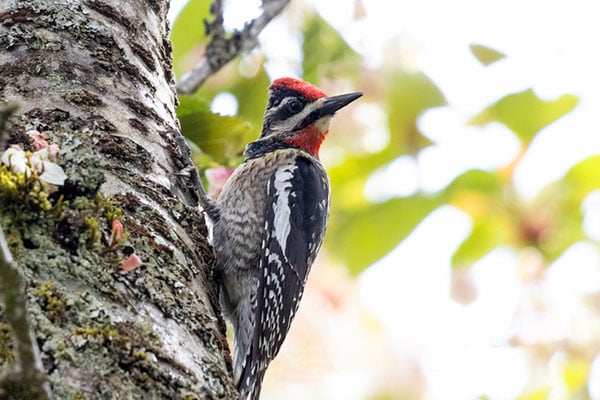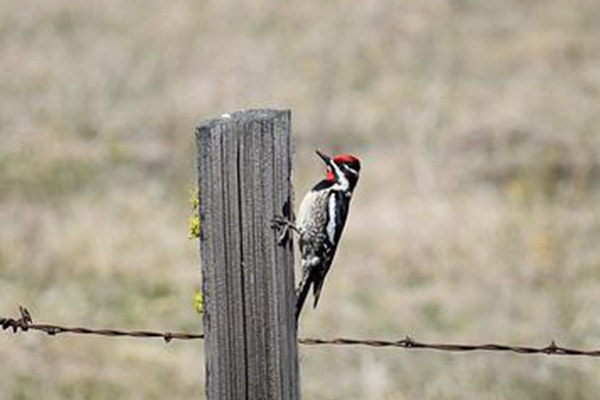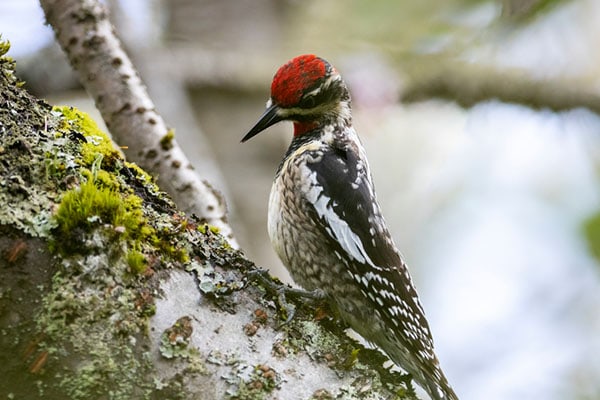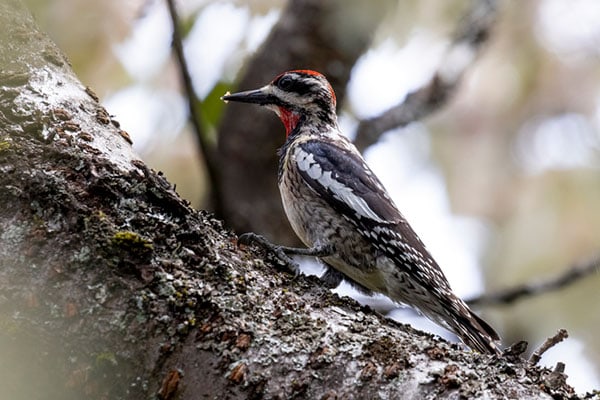Contents [show]
The Red-naped Sapsucker are woodpeckers that love the sweet taste of sugar or sap. When you walk across the forest and find a tree with rows of tiny holes drilled in tree bark, then there’s a big possibility that that’s the work of a Red-naped Sapsucker.
Sometimes, you can also know their presence when you hear harsh wailing cries around you or some stuttered drumming.
In this article, we will learn more about Red-naped Sapsucker. We’ll discuss:
- How to identify them
- Where you’ll find them
- What they eat
- How they nest
- Their behaviors
- How to attract them
- Their conservation status
- Interesting facts
So if you want to learn more about these birds, read on as we go through all the bird facts…

Red-naped sapsucker facts
- Common Name: Red-naped Sapsucker
- Scientific Name: Sphyrapicus nuchalis
- Scientific Family: Picidae
- Life Span: 2-3 years
- Size: 7.5 to 8.3 inches
- Wingspan: 16.1 to 16.9 inches
- Weight: 1.1 to 2.3 oz
- Conservation status: Low Concern
Red-naped sapsucker: how-to identify
Red-naped Sapsuckers are medium-sized woodpeckers with short and straight bills. They grow at around 7.5 to 8.3 inches in length, 1.1 to 2.3 ounces in weight, and 16.1 to 16.9 inches wingspan.
They feature an overall black and white plumage. They have a black back lined with white bars and a mottled chest of black and white.
You’ll also notice that they have a long, white bar on the folded wing, a black stripe through the eyes that are bordered with white stripes, and dark tails with black and white bars. These birds also feature a red cap, red nape, and red throats.
Differences Between Male & Female
The only noticeable difference between male and female Red-naped Sapsuckers is found in their chin. Male birds have red chins while females have white ones.
Differences In Summer Plumage vs Winter Plumage
Red-naped Sapsuckers look the same all year round, regardless of the season.
Red-naped sapsucker bird vocalization
Where You’ll See Red-Naped Sapsuckers
Red-naped Sapsuckers are widespread birds generally found in the western parts of the United States. Breeding populations range from Washington to Montana, going down to Los Angeles and New Mexico, moving past the Gulf of California to Mexico.
These birds are mainly found in deciduous and evergreen forests. They build their nests and feed on various trees, including willow, aspen, birch, juniper, or Douglas-fir trees. You can also find them in gardens, yards, and forest edges from elevations of 1,000 to 10,000 feet.
Red-naped Sapsuckers are short-distance migratory birds breeding in northwestern parts of the US and winter south in Mexico. They usually depart around late August and then head back north around late March or early April.

Red-naped sapsucker diet
The Red-naped Sapsucker’s diet is mainly composed of insects, fruits, and tree sap.
As their name implies, a significant component of their diet is mainly tree saps. They drill rows of circular or rectangular holes into the inner bark of various trees, including:
- Willow
- Birch
- Alder
- Chokecherry
But despite their name, these birds don’t suck the sap from these trees. Instead, they use their specialized tongue to lap the sap up. They also sometimes drill parallel rows of circular holes even before the sap starts to flow.
Aside from the sap of trees, the birds also feed on ants, spiders, beetles, flies, and other insects.

Red-naped sapsucker nesting
- Clutch Size: 3-7 eggs
- # of Broods: 1 brood
- Incubation Period: 8-12 days
- Nestling period: 23-32 days
- Egg Description: White
Red-naped Sapsuckers nest in cavities of live or dead trees, but they prefer to nest on live ones with fungus disease as the heartwood is softer.
These birds often use aspens, western larch, paper birch, Douglas-fir, ponderosa pine, or cottonwood as a nest site and then excavate a hole 6-60 feet above the ground. These birds choose or make their own nest site in three ways:
- Excavate a new hole in a different tree
- Excavate another hole in a tree they’ve used for years
- Reuse an existing cavity or a nesting hole they’ve used for the previous breeding season
Both the male and female help each other create a new cavity, but males do the most work. Nest sites are always about 1.5 inches wide, 1.5 inches tall, and have an entrance of 4.5 inches.
Red-naped sapsucker behavior
Red-naped Sapsuckers, like any other woodpeckers, hitch up and down tree barks using their strong feet and stiff tail feathers for support. However, unlike other woodpeckers, these birds drill circular and rectangular holes in tree barks to lap the sap.
These birds also catch insects in the air when needed. And in winter, they focus more on eating wild fruits and berries.
Both male and female Red-naped Sapsuckers spend most of their time creating and feeding on these sapwells. They can also become territorial in defending their nesting and feeding sites from other sapsuckers and bird species.
Red-naped Sapsuckers threaten enemies by doing the following action:
- Thrusting their heads towards the other bird
- Flicking their wings up
- Raising their chest
- Fluffing their throat feathers, so they look bigger
- Chase the intruder
Some of these actions can even be seen when they’re courting. Most of these birds are found chasing after their prospective mates while making loud, wailing calls. They also face each other with their bills raised, fluff up their throat feathers, raise their crest, and swing their beaks from side to side.
These birds are known to be monogamous, often staying with just one partner throughout one or more breeding seasons.
How-to attract red-naped sapsuckers
Just like with any other bird species, attracting Red-naped Sapsuckers requires you to provide them with their needed food, nesting places, and water.
These birds are not shy around human settlements, which means there’s a good chance they can turn your yard into their home or they might stop by along their migration route to eat some sap, berries, fruits, and other insects around.
Planting some of their favorite trees like aspen, birch, pine, or juniper would help attract these birds as these are known as their feeding or nesting sites. You can also plant some fruit-bearing trees or shrubs to provide them with additional food sources. At the same time, make your yard more insect-friendly.
Like attracting other birds, it would be awesome if you provide Red-naped Sapsuckers with a water source, especially in winter. Try to install a heated birdbath to keep the water warm and the birds that use it.
Red-naped sapsucker threats
Populations of Red-naped Sapsuckers have been stable since 1966. They are common throughout their range, making them species of low concern.
These birds were once shot immediately once sighted in orchards. But due to the efforts of many organizations, the birds are now well-protected species. The practices that maintain the forests also helped make their populations thrive.
Red-naped sapsucker fun & interesting facts
- Red-naped Sapsuckers were once considered the same species as the Yellow-bellied Sapsuckers.
- They are often followed around by some hummingbird species, hoping to steal some sweet sap from them.
- The birds sometimes interbreed with Yellow-bellied Sapsuckers at the eastern range of their breeding range.
- The oldest recorded Red-naped Sapsucker lived for 4 years and 11 months.
- Williamson’s Sapsucker
- Yellow-bellied Sapsucker
- Northern Flicker
- Red-breasted Sapsucker
- Lewis’s Woodpecker
- Acron Woodpecker
- Gila Woodpecker
- Golden-fronted Woodpecker
- Red-bellied Woodpecker
- American Three-toed Woodpecker
- Black-beaded Woodpecker
- Downy Woodpecker
- Nuttall’s Woodpecker
- Red-headed Woodpecker
- Ladder-backed Woodpecker
- Hairy Woodpecker
- White-headed Woodpecker
- Arizona Woodpecker
- Ivory-billed Woodpecker
- Pileated Woodpecker
- Red-cockaded Woodpecker
- Gilded Flicker

